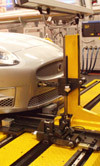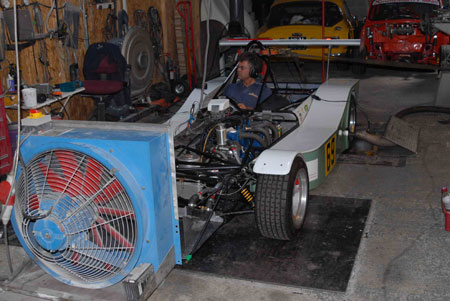The chassis dyno
 Believe it or not measuring the precise output from a reciprocating engine has always been a controversial and sometimes, difficult task. Even in the confines of the engine test cell, day-to day repeatability can often be onerous not to say expensive and so it is easy to understand why many competitors may prefer to test their engine while it remains in the vehicle - on a chassis dynamometer.
Believe it or not measuring the precise output from a reciprocating engine has always been a controversial and sometimes, difficult task. Even in the confines of the engine test cell, day-to day repeatability can often be onerous not to say expensive and so it is easy to understand why many competitors may prefer to test their engine while it remains in the vehicle - on a chassis dynamometer.
Engine dynamometers are generally the province of serious tuners and the OE engine business. Attaching the engine to a fixed means of absorbing the load, be that hydraulic or electric, is at first sight a simple exercise. The independent control over engine speed and load enables many tasks to be undertaken especially those conditions where engine stability is of paramount importance. Within the confines of the test cell, coolant and oil temperatures can be accurately controlled and with a little more care, so can the air inlet temperature. Any one of these can independently have a major influence on engine performance and so for any serious engine development an engine dyno in a test cell is an absolute must.
But there are times when for convenience or simply on the grounds of cost, testing on a chassis dynamometer may be the better solution should the engine installation need to be representative of that in the vehicle. Installing full vehicle exhaust systems in the test cell has always been a problem. Even if the exhaust manifold clears the engine mounting frame, at some time the remaining pipe work will invariably need to pass right through some other fixed part of the cell, normally the dyno itself. Getting the correct under bonnet engine airflow just right can also take much effort and time. When, say, mapping an engine for fuelling and ignition as well the exhaust system, the correct air intake arrangement is also imperative. Especially important for road going vehicles, the only way that this can be done relatively easily, is on the chassis dyno.
Chassis dynos allow the full vehicle to be installed quickly and easily by placing the driven wheels on a set of rollers and measuring the engine output indirectly via the gearbox and differential. Far less repeatable than the engine dyno, it is at least a way of evaluating the wide open throttle performance of an engine under some level of control, albeit basic. Due account will need to be made of the losses through the transmission system and tyres and much care will have to be taken in ensuring the dyno will absorb the full torque of the engine. Many dynos are only suited for emission test work where high engine powers are never experienced. Such emission test dynos may only absorb up to a maximum of around 60kW and so are totally unsuited to most types of performance work.

The other concern is that of the tractive force required between tyre and roller at wide open throttle powers. With some rollers, even with the vehicle tied down heavily against the vehicle springing, the power of the engine can overcome the maximum tractive force available. In the short term this can overheat and burn the tyre leaving a rather acrid smell. If continued it will almost certainly cause the tyre to fail, possibly even burst with all manner of horrendous consequences.
Since the vehicle is stationary while the driven wheels move, the airflow over and around it is also hardly representative of the real situation out on the road or track although in some installations the fan speed can be synchronised to match the road wheel speed thus to some extent simulating this airflow. At best however, this is only an approximation.
But while the engine dyno is necessary for accuracy and the chassis dyno for the convenience, in the end there is no substitute for the real thing out on the track.
Fig. 1 - Chassis Dyno test set-up.
Written by John Coxon